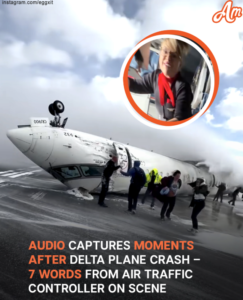On February 17, 2025, Delta Connection Flight 4819, operated by Endeavor Air, experienced a catastrophic landing accident at Toronto Pearson International Airport. The Bombardier CRJ-900LR aircraft, en route from Minneapolis-Saint Paul International Airport, flipped upside down upon landing, resulting in a scene of chaos and emergency response.
Air Traffic Control Audio Reveals Immediate Reactions
Newly released air traffic control (ATC) audio captures the immediate aftermath of the crash, providing insight into the urgency and gravity of the situation. In the recordings, an air traffic controller urgently states, “This airplane just crashed.” Moments later, another voice confirms the severity: “The aircraft is upside down and burning.” These exchanges underscore the shock and rapid assessment by ATC personnel as they coordinated emergency responses.
Incident Details and Passenger Experiences
The aircraft, carrying 76 passengers and four crew members, encountered difficulties during its landing at approximately 2:15 p.m. local time. The plane skidded on the icy runway, overturned, and ignited upon impact. Despite the dramatic nature of the crash, all occupants survived, though 19 individuals sustained injuries, with three reported in critical condition. One critically injured passenger, a four-year-old child, was transported to The Hospital for Sick Children, while two adults were airlifted to Toronto trauma centers.
Passengers recounted harrowing experiences during the evacuation. Survivor John Nelson described the scene: “It was mass chaos… we could smell the jet fuel.” The inversion of the aircraft forced passengers to navigate the cabin’s ceiling to reach exits, adding to the disorientation and panic.
Weather Conditions and Potential Contributing Factors
At the time of the incident, Toronto was experiencing challenging weather conditions, including strong winds and blowing snow. Wind speeds were reported at 51 km/h, with gusts up to 64 km/h, and temperatures around -8.6°C. These factors likely contributed to the aircraft’s instability during landing. Aviation experts have highlighted the potential impact of wind shear, approach speeds, and braking anomalies as areas of investigation. Notably, there were discrepancies regarding runway conditions; while some reports indicated a dry runway with no crosswinds, the prevailing weather suggests otherwise.
Emergency Response and Ongoing Investigation
The immediate response involved the deployment of emergency teams who swiftly managed the situation, ensuring all passengers and crew were accounted for. Toronto Mayor Olivia Chow praised the first responders for their prompt action. Delta Air Lines’ CEO, Ed Bastian, expressed sympathy for those affected and gratitude toward the emergency personnel. The airline has dispatched an incident response team to support the ongoing investigation and assist passengers.
Multiple agencies, including Canada’s Transportation Safety Board and the U.S. National Transportation Safety Board, are conducting a thorough investigation to determine the exact cause of the crash. This process will involve analyzing flight data recorders, cockpit voice recordings, and assessing environmental factors at the time of the incident. The aviation community and the public await the findings to understand the circumstances that led to this alarming event.
